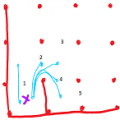Micromouse sensors aligned the easy way
An essential part of setting up a new mouse is the proper alignment of the sensors. You micromouse sensors must have the emitters pointing exactly where you want them to and the detectors have to be aligned to get the best possible response. A simple paper target and an Infra Red camera can help get this right. (more…)

